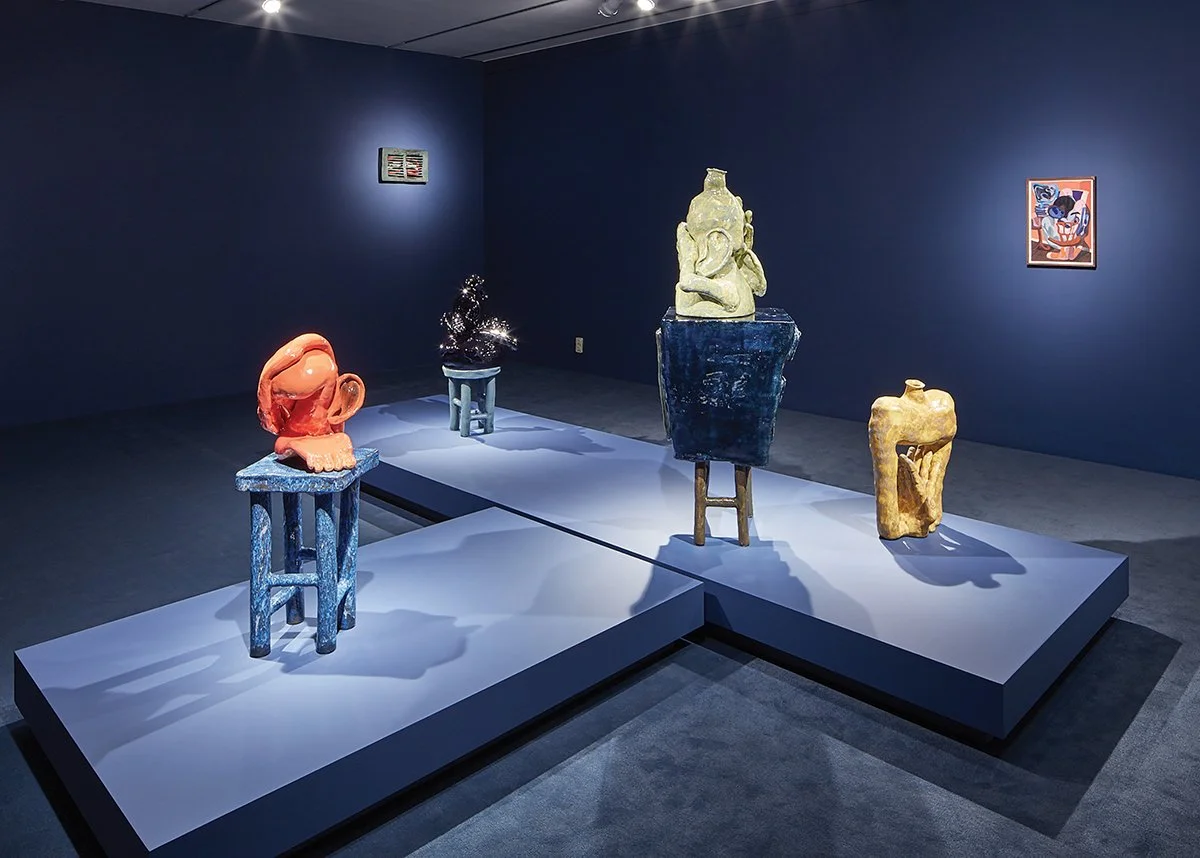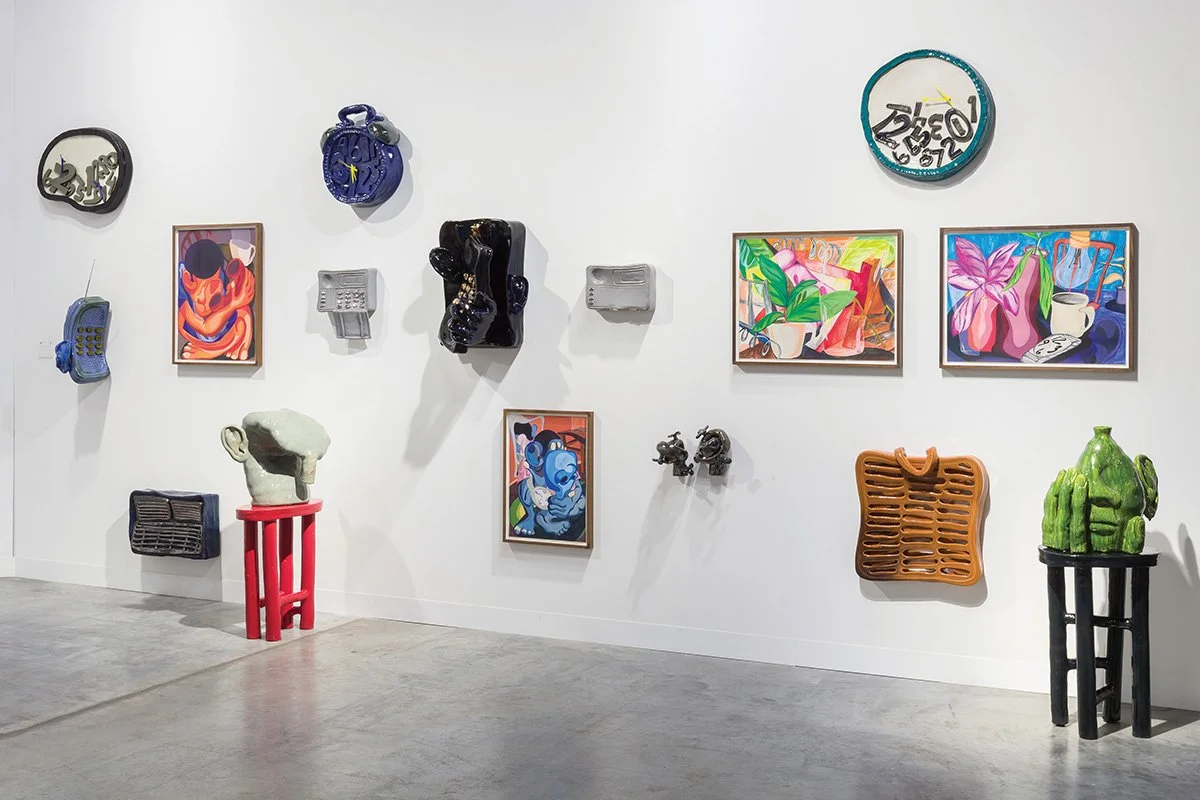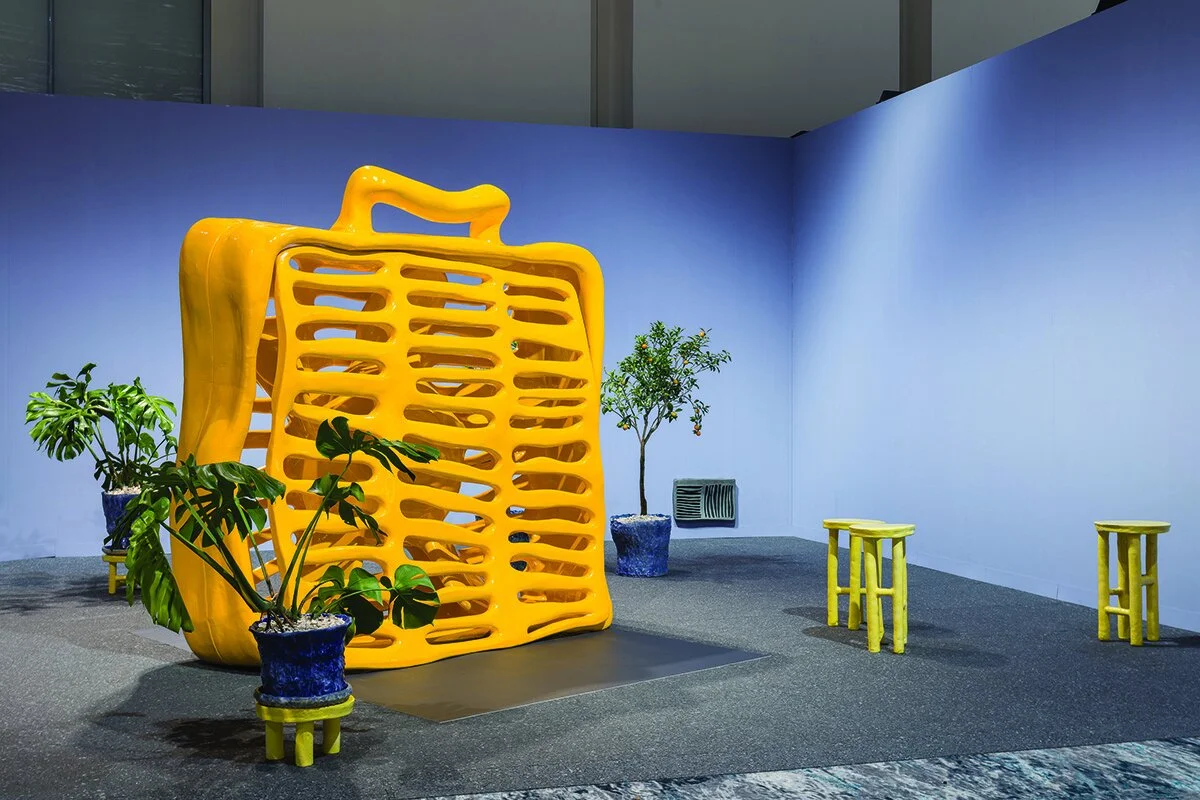Am I Blue?: Woody De Othello's Ceramic Sculptures Give Funk Art a Musical Twist
Published in Art in America, September 27, 2021
By Glenn Adamson
Woody De Othello has been in a blue period for a while now. He has been making beaten-down ceramic sculptures like Defeated, depleted (2018), and Empty Listening and Self Talk (both 2020), torturous compositions of jumbled body parts, of people crushed inward, exhausted by unknown circumstances. They are often glazed in blue-black. The titles tend to reinforce the sense of alienation, as does the occasional inclusion of oversize telephones floating amid the human features. Never have we been more connected, these works seem to say; never have we been more alone.
Self Talk, 2020, ceramic and glaze, 45 by 15 1/2 by 18 inches.
COURTESY JESSICA SILVERMAN GALLERY, SAN FRANCISCO
Are such sculptures a response to the traumas of the past few years—culminating in a period of obligatory isolation, political upheaval, and reckoning with racism? Yes. But to confine their meaning in this way would be a mistake. Pablo Picasso had a blue period too, filled with morose and haunted imagery. Many commentators have offered a biographical explanation of these works, seeing them as a response to the suicide of Picasso’s friend, painter Carles Casagemas. Art historian Rosalind Krauss, in her 1981 essay “In the Name of Picasso,” vociferously dissented from this idea. To see Picasso’s Blue paintings simply as a response to personal tragedy, she argued, “dissociates the work from all those other aspects, equally present, which have nothing to do with Casagemas.” Krauss objected to any interpretive strategy that implies “we have (or so we think) cracked the code of the painting, and it has no more secrets to withhold.”
Self Talk, 2020, ceramic and glaze, 45 by 15 1/2 by 18 inches.
COURTESY JESSICA SILVERMAN GALLERY, SAN FRANCISCO
The same goes for Othello’s heartbreaking sculptures. They were indeed made at a heartbreaking time, but they also have a lot more going on: other aspects, equally present. We can begin with the blues, surely the most important creative context for these works. This music is the wellspring for so much in American culture—critic Stanley Crouch once described it, perfectly, as “the sound and the repository [of] the nation’s sense of tragic recognition.” The way that great blues singers dismantle themselves in public, and are all the stronger for it; their improvisational methodology, at once supremely skilled and hanging out there, loose; their ability to work through a painful subject, rather than around it: all these traits are found Othello’s work. He’s found a way to deal with sorrow, letting it in without giving in. (As Crouch has also observed, “you play the blues to rid yourself of the blues.” To which we might add: and when you’re done, you play the blues again.)
The blues had a correlate in ceramics long before Othello came along, in the form of African American–made face jugs. These vessels, expressively embellished with eyes, noses, and toothy mouths all rendered in coiled clay, were first made in the early 1860s by enslaved Black potters in and around Edgefield, South Carolina. They may well represent ideas transplanted from Central Africa. (Scholars have pointed to nkisi—ritual figures and containers made among Kongo peoples—as probable antecedents.) Really, we can only guess at the intentions that lie behind these powerful ceramics, and the significance they may have had in their communities. But it seems safe to say that, like the blues, they were a way for makers to work through the reality of their surroundings: acknowledging, transforming, and transcending all at once.
Othello’s figures refer explicitly to face-jug typology. They are always part pot,with an overall squat shape. Often, they feature spouts and handle-like appendages. In a few cases, the reference is more head- on, as in Blank Faced (2020) and the earlier Faceless Face Jug (2016). Facial features are conspicuous by their absence in these works, but they are “jug-eared,” clearly signifying a personage. The effect is to suggest some form of erasure—a persistent theme in African American culture, from Ralph Ellison’s novel Invisible Man to Simone Leigh’s Brick House, a commanding figure with conspicuously absent eyes (installed on the High Line in Manhattan in 2019, and now on permanent view in Philadelphia, on the University of Pennsylvania campus).
Works by Othello on view at Jessica Silverman’s booth at Art Basel Miami Beach, 2019.
COURTESY JESSICA SILVERMAN GALLERY, SAN FRANCISCO
There’s another, more recent ceramic backdrop to Othello’s work: the Funk movement, a down-and-dirty, sad-sack counterpart to East Coast Pop. (It took its name from Black jazz musicians’ slang, so Othello’s involvement in it is a knowing reappropriation.) Funk flourished in Northern California during the 1960s and ’70s, and Othello inherited the legacy after moving from his home state of Florida to Oakland (he received his MFA from California College of the Arts in 2017). He has since become enamored of California art history. When I spoke to him this past April, he reeled off a roll call of local greats who’d made an impact on him, including the Bay Area figurative painters, ceramists like Viola Frey and Arthur Gonzales, as well as Barry McGee, Margaret Kilgallen, and other practitioners of the street art–inflected Mission School style.
But Funk is the most obvious influence. Like the artists of the original movement—Robert Arneson preeminent among them—Othello gives pride of place to humdrum artifacts, finding in them a way to expose the “psychopathy” (his word) of the everyday. Oration (2018) recalls one of Arneson’s best-known sculptures, a typewriter with red-tipped fingers for keys; in Othello’s version, the keys are normal but a bright-red page lolls out of the machine like a tongue. He’s also made twisted-up faucets, caved-in air conditioners, a little TV with a permanently blank screen. Often, as with the typewriter, his chosen objects are technologically obsolete. It’s like they’ve been sitting around for a long time, and in the meantime, gravity has had its way with them. They slump as only something made of clay can do. He’s even fashioned clockfaces with the numerals all slipped down to the bottom.
In short, Othello is all in on the attribution of human emotions to inanimate things—what John Ruskin, in the middle of the nineteenth century, called the “pathetic fallacy.” Pathos is very much the point, but the effect is anything but delusional: one object, one figure at a time, Othello is making a world that’s almost too true to bear. His exhibition “Breathing Room,” held at the San José Museum of Art in 2019, was especially intense, with midnight blue walls, platforms, and floor, several contorted figures, and a few paintings with invariably claustrophobic compositions. The project’s title was an obvious allusion to the protest cry “I can’t breathe” (which originated as a tribute to Eric Garner, who suffocated at the hands of New York City police officers in 2014). Yet Othello’s term also suggests freedom, albeit of a provisional kind.
Cool Composition, 2019, on view at Jessica Silverman’s booth at Art Basel Miami Beach, 2019.
COURTESY JESSICA SILVERMAN GALLERY, SAN FRANCISCO
That sort of ambiguity runs through Othello’s work like fresh air, and it blows both ways. In 2019, he created a display in the Jessica Silverman Gallery booth at Art Basel Miami (the art fair held in his hometown). Breezily titled Cool Composition, the installation featured an enormous box fan in bronze, standing taller than its visitors, looking as if it had partially melted in the heat, and painted sunflower yellow. Live plants and narrow stools, like those he often uses as plinths for his figural sculptures, also stood around the space. It was an unusually cheerful installation. But wasn’t there was an ominous subtext to the giant, bladed, circulation-machine? The gallery certainly suggested as much, parsing the fan-sculpture’s meaning thus in its press release: “In an age of global warming, a towering fan may provide solace and escape, but this one also breathes and sighs. It is keen to divulge a secret, share its wisdom, perhaps even proselytize or prophesize.” Maybe so. But—as Krauss might say—it didn’t actually do any of those things. It just stood there, huge and obdurate, a deadpan monument to a confused time, about to get even more confusing.
During our conversation in mid-April, Othello implied that he (perhaps like America?) might be moving out of his blue period, “actively trying to make space for other colors to exist.” He was excited about the new work he was making. He’d been painting a lot, often in the middle of the night, using the relative speed of that medium to generate new ideas for his sculpture. Formal possibilities were opening up for him left, right, and center. He’d been looking into source material—French Surrealism, African ceramics—and finding inspiration. I asked about subject matter, and he replied, “I don’t want to preach. I’m not trying to tell you nothing. Nothing at all.” It sounded to me like a lyric from some old song. And it rang true: the less Othello tells, the more we see.
Solo shows by Woody De Othello are slated for the John Michael Kohler Arts Center, Sheboygan, Wis., Sept. 26, 2021–Sept. 18, 2022, and the Jessica Silverman Gallery, San Francisco, Oct. 2–Nov. 13, 2021.



